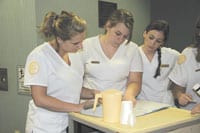Healing Process Wing Memorial’s Wound Care Program Closes A Gap In Needed Services
When Dr. Thomas Canto talks about wound care, he immediately thinks of a man with a leg ulcer who had used bandages to remedy the wound.
After four years, he had found no relief, and the wound kept leaking.
But, after spending four months being treated by Canto in Wing Memorial Hospital’s wound care program, the man’s leg had finally begun to heal for good.
“We’re doing a lot of that,” Canto said — and, though Wing might be one of the few hospitals in the area with a focused wound care emphasis, it’s not the only one.
“Hospital-based wound care is growing in popularity because a lot of people weren’t getting proper care,” Canto said. “It can be very debilitating.”
And it’s also a field most primary care physicians aren’t able to tackle in anything more than a rudimentary way, he told The Healthcare News. As technology and techniques advance further, he added, the role of the wound care specialist will only increase in importance.
A Growing Need
Part of that growing emphasis has to do with the aging of the population. Among the many types of difficult-to-heal wounds are those resulting from traumatic injury, diabetes, peripheral vascular disease, complications from surgery, rheum-atoid arthritis, congestive heart failure, arterial or venous ulcers, and lymphedema — and many of those affect older people in greater numbers than younger patients.
For the patient who had suffered with a non-healing wound for three years, Canto used WoundVAC, a device that applies negative pressure to the wound to aid in closure, as well as a series of compressive dressings. Before that, “he wasn’t getting any better,” Canto said.
WoundVAC (which stands for vacuum-assisted closure), in itself, has helped to revolutionize wound care. Developed by physicians at Wake Forest University in 1995, the technology uses a controlled suction device to close large wounds and promote quicker healing. It also removes infectious material and keeps fluids from pooling in the wound.
The device, composed of a pump, hoses, and a monitoring system, is widely recognized as an effective therapy for patients who don’t adequately respond to traditional dressings. Used in hospitals, nursing homes, and home-care settings, it’s used by some 5 million Americans.
Recognizing that patients were not getting access to such new advances through their doctors, or at the very least had to travel to Baystate Medical Center in Springfield or UMass Medical Center in Worcester for chronic wound care, ad-ministrators at Wing asked Canto to lead a new program in that field after the general surgeon arrived from South Carolina early in 2001.
“It offers a full compliment of care for patients who develop ulcers on their legs or other vascular wounds that just won’t heal,” said Maria Darasz, Wing’s vice president for Ambulatory Care, who touted the program’s location for patients in the Quabog region.
“In the past, we would have to send patients outside the area for wound care,” she said. “Now they can get their care here, close to home.”
Aided by word of mouth and what is indeed a growing need for advanced wound care, the program has grown considerably in the past year and a half, Canto added.
At issue is more than proper healing. In the case of diabetic ulcers of the lower leg and foot, some 67,000 diabetes patients require surgical amputation each year, necessitating lengthy and expensive rehabilitation.
Even for those with less extreme cases, mobility and independence can be casualties of wounds that won’t heal, negatively affecting a patient’s quality of life. With proper care, Canto said, that doesn’t have to be the case.
In most cases, Canto’s staff uses a combination of compressive dressings and topical antibiotics to spur on the healing process. In a few cases, an engineered, multi-layered skin graft process known as Apligraf comes into play, but that’s an expensive undertaking.
In Another Vein
As a general surgeon, Canto doesn’t work only in wound care. Another main focus for him, venous sclerotherapy, is related to wound healing in that varicose veins can lead to leg ulcers and other problems.
There was a time when vein stripping was the generally accepted way to go in removing varicose veins. In that process, the surgeon makes incisions in the leg and actually pulls the problematic section of vein out.
The procedure, which involves a long and painful recovery, is still in wide use, but with a growing emphasis on minimally invasive procedures across the spectrum of medicine, sclerotherapy is a better option for many patients, Canto said.
In that procedure, injections of a sclerosing solution into the abnormal vein destroys the endothelial lining that prevents the vein walls from sticking together.
In layman’s terms, Canto said, the procedure effectively strips the lining from the veins, sucks the water out of the cells, and causes the vein walls to collapse. Blood flow in the vein then ceases, leaving only non-visible scarring.
Of course, sclerotherapy doesn’t reverse the bodily processes that cause varicose veins to form in the first place — and, in the case of mere spider veins, the procedure is not typically covered by insurers, who consider it cosmetic. Varicose veins that cause pain or hinder blood flow are more likely to be covered, Darasz said.
“It’s not magic,” Canto said. “It won’t make the varicose veins go away. If they’ve been developing for 10 years, you’re not going to get rid of them completely.”
The Aging Trend
Whether speaking of varicose veins or chronic wound healing, Canto realizes that America’s rapidly aging population has brought about an increased emphasis on his fields of specialty.
The wound care market in America is estimated to be in the range of $20 billion, and health professionals concede that the trend toward people living longer — and requiring greater and more costly health services — is driving that growth. U.S. Census data suggests that, while about 10{06cf2b9696b159f874511d23dbc893eb1ac83014175ed30550cfff22781411e5} of the population is now considered elderly, that could jump to 30{06cf2b9696b159f874511d23dbc893eb1ac83014175ed30550cfff22781411e5} by 2030.
And with seniors most susceptible to arthritis, congestive heart failure, or simply pressure ulcers — commonly known as bed sores — in nursing homes, that market is here to stay.
If Wing can keep some of those older patients in the Palmer area — many of whom find it difficult to get around — from having to drive to Springfield or Worcester, that alone will lead to a busier wound care department.
“Obviously, if they’re coming to an area close to their home, they’re less likely to miss appointments or say, ‘gee, the travel’s not worth it,’ and they’re more likely to use the services at hand and heal sooner,” Darasz said.
“Some of these people have had disabilities for a long time. Their systems break down, and they need the care. We’re providing them with the ability to feel better about themselves and get back to their lives much more quickly.”



